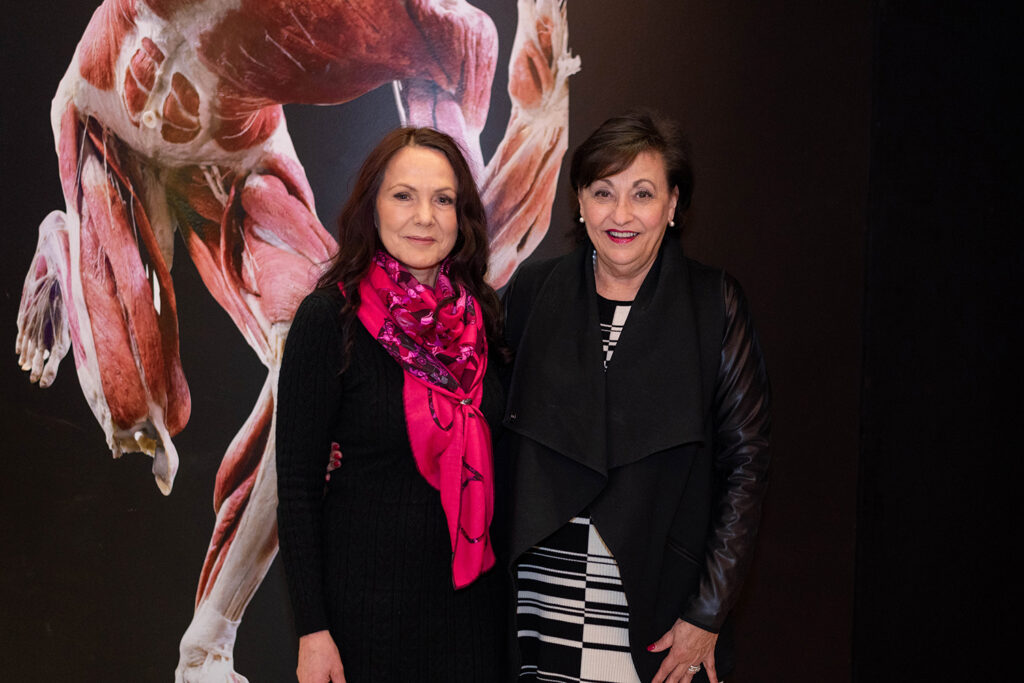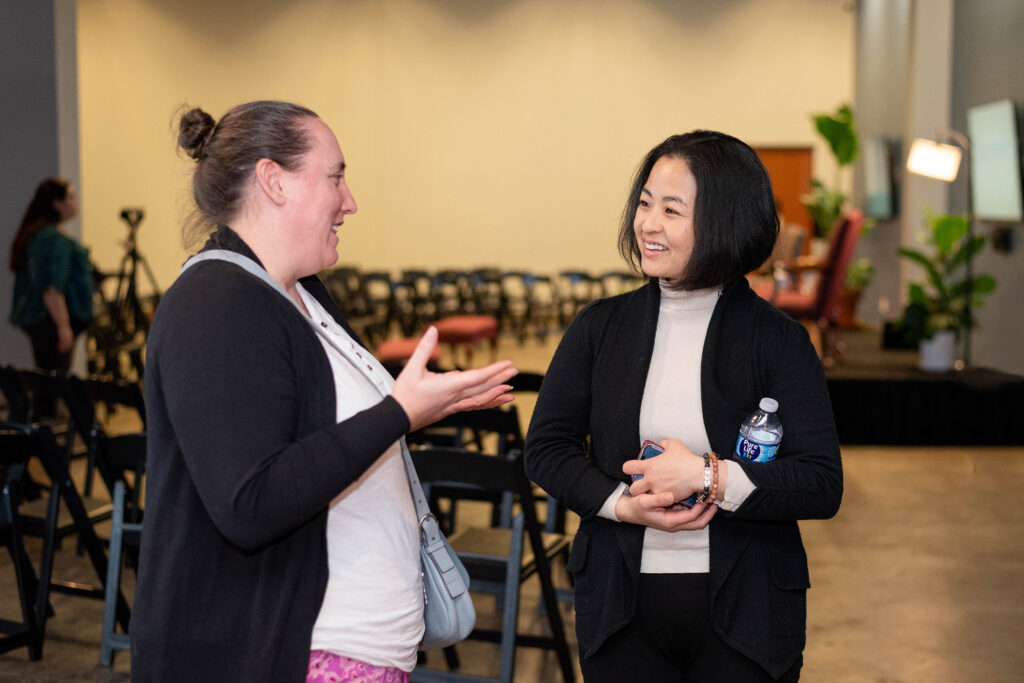The Health Museum welcomed 2 new traveling exhibits: Body Worlds 101 and Reclaimed Creations, on January 23, 2025. We also had the pleasure to host a private conversation with the 2 artists behind the new exhibits. Here are some key highlights from the Q&A session.

John (JA): The two artists met for the first time today. They do completely different types of art, but both help us discover extraordinary beauty in everyday life, from the inside of our bodies to the objects we discard. And interestingly, plastics are central to both of their stories: preserving life in one and giving new life in the other.
Dr. Whalley, tell us about why you created Body Worlds, what’s unique about it?
Dr. Angelina Whalley (AW): Dr. Gunther von Hagens invented the technology of Plastination. It was not meant to become a public exhibition at all. He invented it in 1977 and developed the technology for many years when anatomy was strictly regarded for medical insurance only. You don’t normally do something for the public or artistic in a scientific environment. Later on, the Japanese Association of Anatomists invited us to display the specimens (which looked very much like an anatomical model) in an exhibition at the Tokyo National Science Museum. And it was amazing to see people so much in awe, amazed about what they saw.

We met a young woman at the exhibition who was crying. Eventually, she told us: “I attempted suicide three times in my life. I thought it was nothing. But now when I see how wonderful and intricate the human body is, I feel I have something very important and wonderful inside me. And I promise I will never do that again.”
At that very moment, it became clear to Dr. Gunther and me that we needed to continue with this idea (of anatomical display) because it is an empowering moment when you can see first-hand what you’re making of. We (literally) are our bodies, but we hardly think of it. We take it for granted. We only think about bodies when it doesn’t function properly. This exhibition offered empowering moments where you can see first-hand what you were made of, and gain a completely different view of your inner self. It’s something that The Health Museum does, and nobody else.
Sayaka, your art brings discarded material to life, what drives your creative process and what role do you think art plays in addressing environmental challenges?
Sayak Ganz (SG): I spent my childhood living alone and so when I was nine, my family moved to Brazil; when I was 13 we moved back to Japan; when I was 16 my family moved to Hong Kong, and from there after I graduated from high school, moved to the United States, and now I’m in Indiana where I’ve lived longer than any other place so far. I spent a lot of my childhood feeling like I didn’t belong anywhere, so [the experience] gave me a lot of empathy toward things that don’t belong anywhere. In Japan, they teach children that everything in this world can be your friend, but you can also harm everything at the same time. I was fortunate to find beauty in objects and very personal to me.
My hope is that art will just be able to help people see different potential in these materials that are often overlooked. And just to look, observe, and reflect, that’s the most important thing that art can do to make people look. But for my work, because I care a lot about beauty and aesthetics, I want everything I make to be beautiful, even when the theme is something difficult. I want to elevate the value of these discarded objects. When we don’t value things, when we didn’t pay for this plastic bottle, it’s easy to just forget. And I’ve done this a lot of times. If this plastic bottle becomes a piece of art that you’re connected to, then maybe we’ll be less likely to be dismissive towards it.

The materials you work with are often considered mundane or harmful, how do you bring forth a larger conversation about sustainability out of that?
AW: Well, simply put, it’s a vacuum process that allows us to change the tissue water and the polymer-like citric acid that we most use. Since our body contains about 70 % water, all the specimens are of about 70 % plastic and the rest is human tissue. We need the polypropylene to prevent the species of the specimen. So [Plastination is], leveraging plastics to create the exhibit of the human form, versus taking discarded plastics and creating art.
Artists and scientists often think alike: observing, understanding, and interpreting the world. What is your intention in your creations and how do you reach that understanding, and help people think about the world differently?
SG: For me, I usually start a project based on what animal I want to make, and then I go through two very different processes. During the first stage, I will focus on the framework (which I refer to as an “armature”, like a skeleton to support the weight of all the plastics), measure things carefully, and study the different images of the animal. Next, I painted the armature with the color of the plastic. The rest becomes spontaneous, creative and fun—where I go through the whole piece by attaching the plastics. I will attach one piece, step back, and look at it. If I don’t like the look of it, I’ll take it off and put up something else, or add more. I go through this repetition over and over and feel happy with it.
How do you start with a body, and get your point across?
AW: We are driven by science, and our work is mostly dedicated to showing a very detailed human body. But our specimens need to have an added quality than just a body. We were reminded of the old Renaissance anatomists and artists like Leonardo da Vinci and Michelangelo; when you look at the beautiful images they left behind, you see the anatomical bodies sometimes in post-natural environments, sometimes in beautiful landscapes. So they understood this combination of science and art. That’s when we started to put life back on the course, with a sense of aesthetics, a sense of art, and a sense of dynamics. You need to have a very precise idea of the joints, and how they are related to each other in a particular moment of movement. This process has become a truly artistic work.
Where do you get all the plastics with different colors?
SG: I have a very big collection [of plastics], they come from stores, or somewhere like my neighbor’s trash. Nothing’s new, everything is second-hand.
Which comes first, between your creativity and your curiosity about expanding people’s knowledge?
AW: It’s an ongoing process where both can happen at the same time. If we weren’t invited to Japan for that exhibition, we probably would never consider turning the bodies into a public exhibition. So, once the idea was set in place, our dreams got very wild in what could be done and be achieved.
Having worked with plastics for so long, has it changed your relationship with everyday objects?
SG: For sure it’s made me more environmentally aware. Because I was working so much with plastics, people started sending me articles about plastic pollution, so plastics taught me a lesson about the environment, I even thought about becoming an activist. Later on, I found out it wasn’t sustainable for me, because when I was too focused on getting certain results, it took away my passion from making the work. If I was not enjoying what I was doing, I don’t think anyone else would become interested. So I try to keep things under balance.
JA: I think that sums up the goal of our museum, which is to bring forth the right content about plastics, recycling, the environment, and to appreciate the beautiful artwork done by these two artists.

I want to thank our board and advisory board, and Susan Bickley, the chair of our board, for their continuous support. Susan’s father was the founder of the International Society for Plastination in the 1980s. Her father worked with Dr. Gunther. Thank you all for coming and please enjoy the evening.

